Abstract
Necessary and sufficient conditions for the existence of dissipative electron-acoustic solitons in a cold electron beam plasma with superthermal trapped electrons described by the Schamel equation are derived in this paper. Soliton solutions to the Schamel equation are constructed using formal analytical techniques which yield counter-intuitive conditions for the existence of these solutions. The existence conditions are derived in terms of system parameters and initial conditions. Computational experiments are used to validate the obtained results.
1. Introduction
Dissipative electron-acoustic solitary waves (EASWs) in a cold electron beam plasma with superthermal trapped electrons are investigated in [1]. It is shown in [1] that EASWs can be described by the Shamel equation [2]:
where Φ1 is the linearized electrostatic potential; νc0 is the cold electron-neutral collision frequency; τ and ξ are time and spatial coordinates; A and B are system parameters representing properties of the normalized electron plasma. Eq. (1) shows stronger nonlinearity (due to the √Φ1 term) as compared to the paradigmatic KdV equation.
Eq. (1) is reduced to:
In [1] by assuming the absence of the collision term (νc0=0). It is shown in [1] that using the boundary conditions Φ1→0 and Φ1ξ→0 at ξ→±∞, Eq. (2) produces EASWs through the following solution:
where u0 is the propagation speed of the EASW; Φm=(15u0/8A)2 is the maximum amplitude and Δ=√16B/u0 is the width of the EASW.
The main objective of this paper is to demonstrate that the solitary wave described by Eq. (3) does not satisfy Eq. (2) for all values of parameters A and B, and for all initial (and boundary) conditions.
2. Preliminaries
2.1. Transformation of the Schamel equation
Eq. (2) can be transformed into an ordinary differential equation (ODE) by the wave variable substitution x=ξ-cτ:
where y(x)=y(ξ-cτ)=Φ1(ξ,τ). Integrating Eq. (4) and renaming the parameters yields:
2.2. Extended and narrowed differential equations
The concept of extended and narrowed differential equations is utilized to construct soliton solutions to Eq. (5) in this paper (this concept is discussed in detail in [3]). A short synopsis is presented below. Let us consider the following first-order ODE:
Differentiation of Eq. (7) with respect to x yields:
Renaming the function z to y in Eq. (7) yields a second order ODE:
It is proven in [3] that the solution to Eq. (8) coincides with the solution of Eq. (6) if and only if the initial condition satisfies the following constraint:
Eq. (6) and (8) are referred to as the narrowed and extended equations respectively.
In this paper, an extension of this technique is applied: the soliton solution of the narrowed equation is squared and differentiated – what yields the Schamel equation discussed in [1]. Then the condition analogous to Eq. (9) represents the existence condition for soliton solutions.
3. Soliton solution to the Schamel equation
Consider the following differential equation:
Denoting y=σ2z2 and differentiating Eq. (10) yields:
Eq. (11) can be rewritten in respect to z in the following form:
Combining Eqs. (10) and (12) results in the following polynomial:
=b3σ3z3+b2σ2z2+b1σz+b0.
The values of b0,…,b3 for which Eq. (11) is the extension of Eq. (10) are determined from Eq. (13):
As observed in [4], the solution to Eq. (10) satisfies Eq. (11) if and only if the initial conditions satisfy the following constraint:
Note that b1=0 for the Schamel equation. Then special cases of Eq. (11) must be considered, because it follows from Eq. (15) that the parameters of Eq. (10) must satisfy the following relation:
3.1. Existence conditions for soliton solution to the Schamel equation
Following the assumptions in [1] we set z1=z2=0. Without loss of generality let us assume that z3=-β, β>0. Then, Eq. (19) is satisfied and the equation with respect to z reads:
with the initial condition z(x0)=s. Also, note that in this case b0=0 and b2,b3 read:
As shown in [4] (Eqs. (49) and (61) in [4]) equation Eq. (20) admits the following soliton solution:
Note that Eq. (22) is equivalent to:
The function:
is a solution to Eq. (5) if its initial conditions do satisfy v=±2αu√β+√uσ. Note that Eq. (24) is a soliton solution and takes the same form as Eq. (3).
4. Computational experiments
It can be seen from Eq. (22) that soliton solution Eq. (24) to Eq. (5) has a singularity if b3>0. Further, only the soliton solution without singularity is considered.
Let us consider the following partial differential equation, as described in [1]:
Selecting the substitution x=ξ+2τ and denoting y(x)=y(ξ+2τ)=Φ1(ξ,τ) results in the following third-order ODE:
Integrating Eq. (26) with respect to x yields:
Note that if A=-32, B=-1, c=-2 then Eq. (27) coincides with Eq. (4).
As follows from the previous subsection 3.1 (Eqs. (24)), (27) admits the following soliton solution:
if and only if initial conditions u, v of Eq. (27) do satisfy the following constraint:
Soliton solution Eq. (28) is depicted in Fig. 1.
Returning to the original PDE (25), the soliton solution reads:
Fig. 1Soliton solution Eqs. (28) to (27) for u=110, v=150-101250
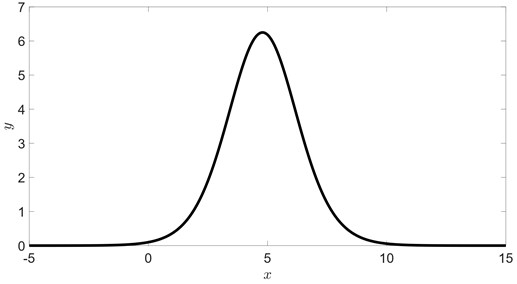
This solution is depicted in Fig. 2.
Fig. 2Soliton solution Eqs. (30) to (25) for u=110, v=150-101250
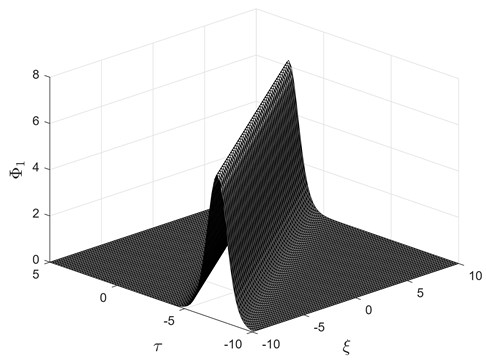
Constraint Eq. (29), ensuring that the solution to Eq. (27) has soliton form Eq. (28), can be illustrated via numerical integration. The error between analytical soliton solution Eq. (28) and the approximate solution to Eq. (27) (denoted as ˆy(x,x0,u,v)) is estimated using a constant-step, time-forward integrator as follows:
where h denotes the integration step-size; N is the number of integration steps. If soliton solution Eq. (28) to Eq. (27) would hold for all initial conditions (x0,u,v), then the error Δ(x0,u,v) would be zero for any (x0,u,v). However, Figs. 3, 4 demonstrate that this is not the case since the errors are close to zero only on the curve defined by Eq. (29).
Fig. 3The surface plot of the error Δ=Δ(x0,u,v) between Eq. (28) and the numerical solution to Eq. (27) for 0≤u≤6.5, -10≤v≤10. The error is evaluated using the step-size h= 0.01 and N= 100 time-forward steps. Errors higher than 5 are truncated to 5 for clarity. Note that the error is close to zero only on the curve defined by Eq. (29)
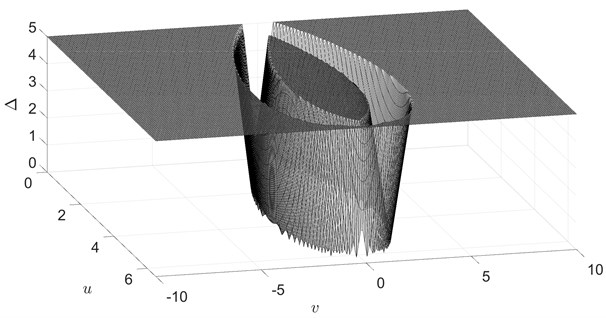
Fig. 4Black line in part (a) depicts the constraint Eq. (29), gray circle and gray diamond correspond to initial conditions (u,v) used in parts (b) and (c) respectively. Gray line in parts (b) and (c) displays an approximate solution to Eq. (27) (y^=y^(x,x0,u,v)), black line - analytical soliton solution Eq. (28) (y=y(x,x0,u,v)). It can be seen (part (b)) that approximate solution y^ and y coincide if initial condition (u,v) lies on the curve defined by Eq. (29). Otherwise, y^ and y are different (part (c))
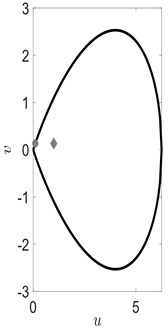
a)
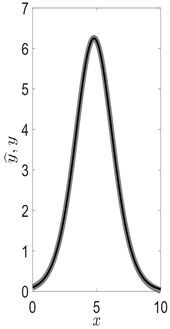
b)
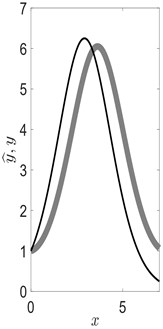
c)
5. Conclusions
Soliton solutions to Schamel equation considered in [1] are constructed using the concept of narrowed and extended differential equations. Necessary and sufficient conditions for the existence of these solutions have been derived in the space of equation parameters and initial conditions.
References
-
S. A. Shan, “Dissipative electron-acoustic solitons in a cold electron beam plasma with superthermal trapped electrons,” Astrophysics and Space Science, Vol. 364, No. 2, Feb. 2019, https://doi.org/10.1007/s10509-019-3524-1
-
H. Schamel, “A modified Korteweg-de Vries equation for ion acoustic wavess due to resonant electrons,” Journal of Plasma Physics, Vol. 9, No. 3, pp. 377–387, Jun. 1973, https://doi.org/10.1017/s002237780000756x
-
Z. Navickas, M. Ragulskis, and L. Bikulciene, “Be careful with the Exp-function method – Additional remarks,” Communications in Nonlinear Science and Numerical Simulation, Vol. 15, No. 12, pp. 3874–3886, Dec. 2010, https://doi.org/10.1016/j.cnsns.2010.01.032
-
Z. Navickas, L. Bikulciene, M. Rahula, and M. Ragulskis, “Algebraic operator method for the construction of solitary solutions to nonlinear differential equations,” Communications in Nonlinear Science and Numerical Simulation, Vol. 18, No. 6, pp. 1374–1389, Jun. 2013, https://doi.org/10.1016/j.cnsns.2012.10.009
About this article
The authors have not disclosed any funding.
The datasets generated during and/or analyzed during the current study are available from the corresponding author on reasonable request.
The authors declare that they have no conflict of interest.

